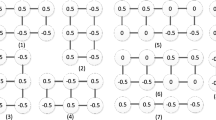Abstract
Many innovation modules introduced by High Efficiency Video Coding (HEVC) are remaining unexplored in the steganography domain. In this paper, a novel steganalytic approach is proposed against the PU partition mode-based steganographic methods which makes use of some innovative features in HEVC. Firstly, the influence of multilevel information embedding on the group proportion and the group proportion difference before and after recompression is analyzed. Then the statistical distribution of these two aspects are modeled as two different feature sets, and these two feature sets are combined for the final feature design to generate a 24-dimensional classification feature. Finally, a feature optimization is applied to reduce the 24-dimensional steganalysis feature to a 6-dimensional feature. It is demonstrated in experiment results that the proposed features have achieved a more accurate detection rate than current steganalysis methods under various circumstances, especially in the low embedding level situation.









Similar content being viewed by others
References
Aly HA (2010) Data hiding in motion vectors of compressed video based on their associated prediction error. IEEE Trans Inf Forensics Secur 6(1):14–18
Cao Y, Zhang H, Zhao X, Yu H (2015) Video steganography based on optimized motion estimation perturbation. In: Proceedings of the 3rd ACM workshop on information hiding and multimedia security. ACM, pp 25–31
Cao Y, Zhao X, Feng D (2011) Video steganalysis exploiting motion vector reversion-based features. IEEE signal Process Lett 19(1):35–38
Chang CC, Lin CJ (2011) Libsvm: a library for support vector machines. ACM Trans Intell Syst Technol (TIST) 2(3):1–27
Chang PC, Chung KL, Chen JJ, Lin CH, Lin TJ (2013) An error propagation free data hiding algorithm in hevc intra-coded frames. In: 2013 Asia-pacific signal and information processing association annual summit and conference. IEEE, pp 1–9
Chang PC, Chung KL, Chen JJ, Lin CH, Lin TJ (2014) A dct/dst-based error propagation-free data hiding algorithm for hevc intra-coded frames. J Vis Commun Image Represent 25(2):239–253
Dong Y, Sun T, Jiang X (2018) A high capacity hevc steganographic algorithm using intra prediction modes in multi-sized prediction blocks International workshop on digital watermarking. Springer, pp 233–247
Fridrich J, Goljan M, Hogea D (2002) Steganalysis of jpeg images: Breaking the f5 algorithm. In: International workshop on information hiding. Springer, pp 310–323
Li S, Deng H, Tian H, Dai Q (2014) Steganalysis of prediction mode modulated data-hiding algorithms in h. 264/avc video stream. Ann Telecommun 69 (7-8):461–473
Li Z, Meng L, Xu S, Shi Y (2019) A hevc video steganalysis algorithm based on pu partition modes. Comput Mater Continua 59(2):607–624
Liu P, Li S (2020) Steganalysis of intra prediction mode and motion vector-based steganography by noise residual convolutional neural network. In: IOP Conference series: materials science and engineering, vol 719. IOP Publishing, p 012068
Liu Y, Ju L, Hu M, Ma X, Zhao H (2015) A robust reversible data hiding scheme for h. 264 without distortion drift. Neurocomputing 151:1053–1062
Liu Y, Liu S, Wang Y, Zhao H, Liu S (2019) Video steganography: a review. Neurocomputing 335:238–250
Ma X, Li Z, Tu H, Zhang B (2010) A data hiding algorithm for h.264/avc video streams without intra-frame distortion drift. IEEE Trans Circ Syst Video Technol 20(10):1320–1330
Sheng Q, Wang R, Huang M, Li Q, Xu D (2017) A prediction mode steganalysis detection algorithm for hevc. J Optoelectron-laser 28 (4):433–440
Sullivan GJ, Ohm JR, Han WJ, Wiegand T (2012) Overview of the high efficiency video coding (hevc) standard. IEEE Trans Circ Syst Video Technol 22(12):1649–1668
Tew Y, Wong K (2014) Information hiding in hevc standard using adaptive coding block size decision. In: 2014 IEEE International Conference on Image Processing (ICIP). IEEE, pp 5502–5506
Wang J, Wang R, Xu D, Li W (2015) An information hiding algorithm for hevc based on angle differences of intra prediction mode. JSW 10 (2):213–221
Wang K, Zhao H, Wang H (2014) Video steganalysis against motion vector-based steganography by adding or subtracting one motion vector value. IEEE Trans Inf Forensics Secur 9(5):741–751
Xie W, Yang Y, Li Z, Wang JW, Zhang M (2018) An information hiding algorithm for hevc videos based on pu partitioning modes. In: International conference on cloud computing and security. Springer, pp 252–264
Yang J, Li S (2018) An efficient information hiding method based on motion vector space encoding for hevc. Multimed Tools Appl 77(10):11979–12001
Yang Y, Li Z, Xie W, Zhang Z (2019) High capacity and multilevel information hiding algorithm based on pu partition modes for hevc videos. Multimed Tools Appl 78(7):8423–8446
Zhai L, Wang L, Ren Y (2017) Combined and calibrated features for steganalysis of motion vector-based steganography in h. 264/avc. In: Proceedings of the 5th ACM workshop on information hiding and multimedia security. ACM, pp 135–146
Zhai L, Wang L, Ren Y (2019) Universal detection of video steganography in multiple domains based on the consistency of motion vectors. IEEE Trans Inf Forensics Secur 15:1762–1777
Zhang H, Cao Y, Zhao X (2016) Motion vector-based video steganography with preserved local optimality. Multimed Tools Appl 75(21):13503–13519
Acknowledgements
This work is funded by the National Key R&D Program of China (2018YFC0830700, 2018YFC0831405). It is also supported by(Grant No.61572320).
Author information
Authors and Affiliations
Corresponding author
Additional information
Publisher’s note
Springer Nature remains neutral with regard to jurisdictional claims in published maps and institutional affiliations.
Rights and permissions
About this article
Cite this article
Huang, K., Sun, T., Jiang, X. et al. Combined features for steganalysis against PU partition mode-based steganography in HEVC. Multimed Tools Appl 79, 31147–31164 (2020). https://doi.org/10.1007/s11042-020-09435-y
Received:
Revised:
Accepted:
Published:
Issue Date:
DOI: https://doi.org/10.1007/s11042-020-09435-y




